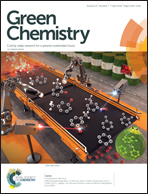Addressing the energy sustainability of biowaste-derived hard carbon materials for battery electrodes†
Abstract
Dealing with the increasing need for battery electrodes materials, renewable and widespread resources – such as bio-derived hard carbon – are under investigation to find a sustainable alternative to state-of-the-art materials, suffering for scarce availability with regard to rising demand. Hence, in a manufacturing scenario governed by the concept of circular-economy, bio-waste derived materials are attracting much interest. Nonetheless, the manufacturing process to transform bio-waste (for instance, hard carbon production via pyrolysis) needs also to be low-energy demanding to achieve overall sustainability. This paper presents a generalized model to account for the energy balance of hard carbon synthesis via bio-waste pyrolysis. In detail, the model provides an evaluation of the pyrolysis heat of reaction, weight reduction and pyrogas yield. Despite the calculation is not considering the exact thermal decomposition kinetic, the model is flexible and easy to implement, showing great usefulness for the energy balance estimation of a process characterized by a huge variability, especially with regard to a primary feedstock like bio-waste. The model is validated against the experimental characterization of depectinised apple pomace-derived hard carbon, which represents a conspicuous bio-waste from the food industry and thereby an excellent candidate for the production of sustainable electrode materials.



 Please wait while we load your content...
Please wait while we load your content...